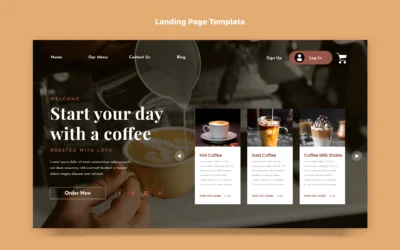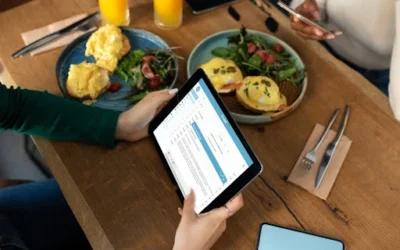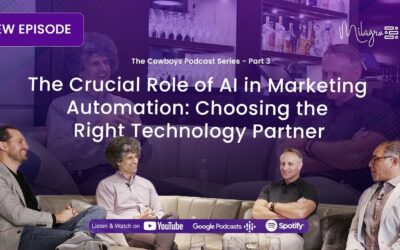The Future of Restaurant Marketing: Leveraging the Power of a Customer Data Platform (CDP)During the COVID pandemic, it became evident that restaurants that had not adopted technology struggled to stay afloat. In fact, 20% of those who closed never reopened. On the other hand, those who embraced technology were able to thrive, with some even seeing significant growth in sales. One example of this is It’s Just Wings, a new concept that Brinker International spun up as a “Ghost Kitchen,” which saw its revenues increase from $0 dollars to $150 million dollars in just 12 months! It is an incredible story of how they utilized what they already had, in terms of food and technology in order to increase revenues while every other restaurant was struggling to figure out what to do next. It’s clear that in today’s environment, a restaurant without a customer data platform (CDP) is at a disadvantage and will continue to struggle to survive.
“It’s Just Wings continues to perform well, and we’re on track to hit that $150 million target we set at the beginning of the year,” said Wyman Roberts, chief executive officer and president of Brinker International. “Almost all of our domestic franchise partners jumped on the opportunity, and globally, several of our partners have already picked it up.” Its Just Wings is now in 9 countries and 160 locations outside the US, making it a formidable brand in just its first year.” This is the former CEO of Brinker describing the success of a brand that was launched in the middle of the worst pandemic since the 1920s!
The impact of technology on restaurants has been immense. Those who had already adopted technology were able to quickly pivot and take advantage of the situation to take business away from those who had failed to utilize technology. It’s clear that restaurants without a strong technological foundation are at risk of failure. These are the restaurants that continuously complain and hide behind the notion that restaurants have thin margins, when in fact, it is their own decision-making that leads to having thin margins.
Fast forward to today, where there are a lot of discussions around knowing your customer, which leads to the implementation of a customer data platform (CDP). So let’s dig into the details of how CDP can help boost your sales and profits to get away from the notion that restaurants have thin margins.
What is a Customer Data Platform (CDP)?
To start, it is imperative that we clearly understand what a CDP is. A Customer Data Platform is a powerful, centralized system that stores and organizes all customer data from various sources, including transactional data from POS systems, online orders, gift cards and loyalty programs, customer feedback, waitlists and reservations, and any other interaction with your customers.
CDP stores important information such as first and last name, phone number, email address, how often they visit your restaurants, their average spend, favorite menu items, birthday, anniversary, and, in some advanced CDPs, their lifetime value and, more importantly, the ROI of each individual customer. It is important to note that a CDP is not simply a list of your loyalty members, which only includes a subset of your customers, but rather a comprehensive database of all of your customers, regardless of their loyalty status.
Furthermore, the best CDP gathers information from every interaction that a customer will have with your restaurant. So gathering information from a loyalty app and gathering a separate set of information from the online ordering app does not qualify each of those platforms to be a CDP. It is imperative to have a single source of truth across all apps and across all of your locations. Having silos and storing information in different apps, is not a CDP.
Now that we have clearly understood what a CDP is, let’s talk about the most important role of a CDP.
Where does the data come from?
A customer data platform (CDP) in a restaurant collects information from various sources, such as point-of-sale systems, online ordering platforms, customer surveys, loyalty program, waitlist and reservation apps, gift cards, marketing automation platforms (email, text, push notification), and social media.
How do restaurants increase sales and profits using a CDP?
Let us start with an example that will clearly define the importance of a CDP and show how it leads to increased sales & profits in a restaurant. Let’s take a restaurant that has 1.2 million customer emails but has no details other than first and last names. Let’s compare that with another restaurant chain with only 120,000 people in their database, however, they have actionable and transactional information about all the customers.
The first restaurant will continue to send out its kids eat free offer on the first Tuesday of every month, but due to lack of data, 75% of those customers do not have any kids. This means that irrelevant messaging and mass marketing will result in those customers opting out of future marketing. Furthermore, the restaurant is wasting resources by reaching out to the wrong audience, therefore, reducing their profit margins by wasting money, and hence, complaining that they have thin margins.
On the other hand, the second restaurant will send out the same kids eat free offer to 25% of their customers, all of whom have kids. At the same time, the second restaurant will also send out three other marketing campaigns, each of which focuses specifically on a highly targeted demographic, such as vegetarians, wine lovers, and meat lovers. Even though the second restaurant has fewer people in their database, they are much more successful because the messages are highly personalized and targeted to the specific subsets of customers they are trying to reach. Not only are they saving marketing resources, but they also have a much higher return on investment than a typical mass marketing campaign, as demonstrated in the first restaurant example. In fact, the second restaurant, will on average, be six times more effective than the first one. This is common sense, if your message is relevant, you have a higher response rate. This is why Google and Facebook ads are so effective. They are presented at the point of purchase when someone is searching for that product.
Imagine if your favorite restaurant continued sending you kids eat free when you don’t have kids, alcohol specials when you don’t drink and meat lovers specials when you are a vegetarian. What are the chances of you responding to such messages?
The true impact of a CDP is its ability to real-time gather information in real time, sort through it, and create actionable results that can be used to personalize marketing, i.e., monetize the transactional data of your customers.
Moving on, let’s compare CDPs.
Are all CDPs created equal?
Of course not. Just like the example before, where you would want your kids’ eat free offer to go to those with kids, a CDP must be focused on your specific industry. Although most of the information may be the same across multiple different CDPs, the ones focused on your specific industry will adjust for the nuances and are much more effective.
By the way, a CDP that simply provides a whole bunch of data is useless. If you cannot monetize the CDP data, then why have it to begin with? Remember, Knowledge is NOT power, Actionable Knowledge is Power. Knowing what to do and how to monetize the information while elevating the customer experience, is the true power behind any CDP.
What is an actionable, transactional CDP?
A CDP that does not contain transactional data, meaning it is not tied to the customer’s purchase behavior, is the most useless form of a CDP. Without transactional data tied to an individual customer, you are unable to make any significant decisions that will drive significant profits.
The second most useless form of a CDP is a transactional but non-actionable CDP. For example, a CDP that gathers all the information and puts it in a single database but provides no actionable insights that can be used to make a decision. Now you have to hire someone to sift through it, make the connections, and figure out how to monetize the data. This, in and of itself, is a massive undertaking.
The best and most valuable CDP is the one that you would never have to interact with. For example, you have a wine special featuring a new winery. You should be able to create a marketing campaign, choose the channel to deliver your message through, i.e., email, text, push notification, choose what physical market it should be delivered to, for example, the DFW market, and very importantly, it should be delivered to those who love wine and appreciate the opportunity to be introduced to a new brand of wine. The magic happens behind the scenes, and this allows any user to be able to use the data in order to increase sales.
Let’s face it, no one has the time nor the resources to be always seeking and sorting through information. The most powerful CDP‘s are the ones with automated business logic to do the work on your behalf.
Furthermore, the best CDPs will gather the customers’ transactional behavior and cross-reference that information with the customers’ satisfaction, then cross-check that with the social media profiles of those customers, check the data against the customer’s lifetime value, and automatically reach out to that specific customer to create a new brand ambassador at minimal cost, and all entirely automated. Harnessing the followers of your most loyal, most satisfied, and highest spenders with a noticeable social media presence delivers a business impact that is truly priceless. For a great example, search for “Mr. Beast Burger.” a YouTuber who started a burger chain and sold out beyond anyone’s expectations. In fact, all systems crashed due to the immense volume of sales. The lines for the opening reached as far as 20 miles, so much so that the police department requested to have the line closed. This is the priceless value of social media, to use your most loyal fans and draw their followers to your brand.
Over the top or built-in CDP?
The next big question is whether you should buy a CDP that sits on top of all of your apps and integrates in order to pull the information or buy a platform that natively has a CDP. One thing to keep in mind is when integration is created, it is with a specific goal, so if the business objective changes or the system is limited by the current imagination of both companies, then constant integrations for missing links are always required. A native CDP will eliminate this issue because the information is always stored and available to be used.
With today’s fast pace of change in technology, the implementation of machine learning, and artificial intelligence, if data is not available because it was not taken into consideration during integration, those small pieces of missing information will have a drastic impact on the interpretation of your data.
On the other hand, it is nearly impossible to find a CDP that checks all the boxes, including having all of its own native apps. So there are clearly pros and cons to each approach, however, we believe that a native CDP is always better than one that is over the top, or OTT.
Lastly, there are a lot of improvements being made in Artificial Intelligence and that brings us to the next section.
CDP with built-in machine learning and artificial intelligence
There are currently a lot of advancements around Artificial Intelligence and machine learning. Even though eventually such systems will replace all manual processes, currently, in the grand scheme of things, they are still a couple of years away for restaurants. That limitation is actually not on the underlying technology of AI but more so on the lack of data available in the restaurant industry. A proper ML or AI engine requires years of data to be effectively trained to make informed decisions. Just like you, the restaurant owner, your experience has come from years of being in the industry and learning from the ups and downs. That said, there are great advances being made in the automation of data analysis, which allows the removal of the majority of the manual labor.
AI is absolutely here to stay, and if you do not embrace it, it will have a catastrophic impact on your business. If you wait just 12 months after your competitors implement this, you will be at least 24 months behind them.
Word of advice to all restaurant owners
If you are planning on owning and operating your restaurant in the future, we strongly recommend you implement a customer data platform now. The time to implement a CDP was yesterday. The more information you have about your customers, the higher your chances of prospering in the future. When those AI systems take over, you do not want to be the one who has to wait 12 to 24 months to have the data required in order to utilize such systems. By then, it will absolutely be too late for you to compete.
In the next episode, we will discuss how to implement a successful loyalty app and how to utilize it to help increase sales and profits in restaurants. We hope you enjoyed this conversation. Stay tuned and subscribe to be notified when we release future episodes.
Unlock valuable information by reading our blog why customer data is imperative for restaurant operations.





